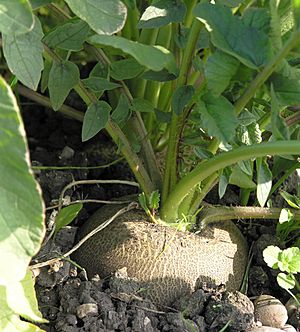Black radish facts for kids
Quick facts for kids Black radish |
|
|---|---|
 |
|
| Black radish, round variety | |
| Scientific classification | |
| Kingdom: | |
| (unranked): | |
| (unranked): | |
| (unranked): | |
| Order: | |
| Family: | |
| Genus: |
Raphanus
|
| Species: |
R. raphanistrum
|
| Subspecies: |
R. raphanistrum subsp. sativus
|
| Binomial name | |
| Raphanus sativus var. niger (L.) J. Kern |
|
The black radish (Raphanus sativus L. var. niger J. Kern) is a type of root vegetable. It belongs to the Brassicaceae family, which also includes plants like cabbage and mustard. This special radish is often called Black Spanish radish or Erfurter radish.
It has a tough, black outer skin and white flesh inside. You can find black radishes in both round and long shapes. Just like other radishes, the black radish has a strong, sharp taste. This flavor comes from natural chemicals the plant makes to protect itself from pests.
Contents
Where Does Black Radish Come From?
Scientists are still learning about the full history of radishes. It's thought that the black radish probably came from a wild plant called Raphanus maritimus. Other types of radishes, like the ones we eat in spring, might have come from a different plant.
People in Ancient Egypt grew radishes a very long time ago. Pictures in old tombs show them using a long kind of radish. The black radish likely first grew in the area that is now Syria.
It was first written about in Europe in 1548. Back then, it was a very common type of radish. Over time, new radish varieties became popular, and the black radish was grown less. By the late 20th century, it was almost "forgotten" in European cooking. But now, it's becoming popular again as a healthy food, especially thanks to mentions in health and food magazines.
How Does Black Radish Look?
The black radish is an annual plant, meaning it grows for one season. Its root has a black or dull brown skin and white flesh. Black radishes are usually bigger than the spring radishes you might know. They can grow to be about 7 to 10 centimeters (3 to 4 inches) wide or long. The whole plant can even grow up to 0.5 meters (20 inches) tall! Depending on the specific type, the radishes can be round, cylinder-shaped, or long.
How to Grow Black Radish
Black radish takes about 35 to 55 days, or sometimes longer, to grow fully. You can plant the seeds from mid-summer to autumn, depending on where you live. Then, you can harvest them in autumn or winter.
It's important to avoid very hot temperatures while they are growing. If it's too hot, the radishes can become tough and spongy. You can plant the seeds directly in your garden or start them indoors and then move them outside.
When planting, make sure the plants are spaced about 5 to 10 centimeters (2 to 4 inches) apart. If you want bigger radishes, give them even more space. The seeds should be planted about 0.6 to 1.2 centimeters (1/4 to 1/2 inch) deep.
Black radishes need soil that drains well and is a bit sandy, called loam. The soil should have a pH level between 5.9 and 6.8. They also need about six to eight hours of sunlight each day. You know it's time to harvest when the top part of the radish starts to poke out of the soil.
Some common pests that might bother black radishes include cabbage root maggots, cutworms, and flea beetles.
For storing, if the weather is cold, you can leave the mature radishes in the ground. They can also be kept for many months in a cool, dark place like a root cellar. In your fridge, they can stay fresh for up to three weeks at temperatures between 0 and 5 degrees Celsius (32 to 41 degrees Fahrenheit).
Eating Black Radish
Black radish can be eaten in many ways! You can enjoy it raw in salads, or you can cook it in soups or stews. As long as the black skin looks fresh and doesn't smell moldy, you can eat that part too.
If the strong taste of the raw radish is too much for you, try adding some salt to it. This can help make the flavor milder.
Traditional Uses
For a long time, people have used black radish juice in traditional medicine. Since ancient times, it has been believed to help with bile function, which is important for digestion. Black radish has been used for centuries in parts of Asia, Africa, and Mexico for various health reasons.
Black radish juice contains special compounds called glucosinolates. Two of the most common ones are Glucoraphasatin and glucorapanin. Because of these compounds, black radish has been studied to see if it could help prevent certain health issues, like cholesterol gallstones.
See also
 In Spanish: Raphanus sativus subsp. niger var. niger para niños
In Spanish: Raphanus sativus subsp. niger var. niger para niños


